#zupaysaurus
Explore tagged Tumblr posts
Text


THEROPODA basal.
Some of the theropod dinosaurs shown on the video dedicated to Basal Theropods of the Triassic- Jurassic periods. This chart is now also available for prints and more at Redbubble
From my new video about Basal Theropods .
___
Youtube channel
Instagram
Prints and more paleoart merch
#theropoda#dinosaurs#paleoart#zupaysaurus#dracovenator#sinosaurus#liliensternus#daemonosaurus#dinosaur#paleontology#scientific illustration#natural history#size comparison#jurassic#triassic#saltriovenator
60 notes
·
View notes
Text

Captured in the jungle by SRleotrex444.
8 notes
·
View notes
Text

A messily sketched Zupaysaurus from a few days ago, because I was bored. Rare new art!! (not good stuff tho)
12 notes
·
View notes
Note
Trick or Treat!
My research reveals there's an Allosaurus And a dinosaur called a Zupaysaurus. As you can readily see, I have searched from A to Z, But am yet to find one called a Thesaurus!

Sun Conure!
14 notes
·
View notes
Text
Oggi ho terminato un piccolo lavoretto che rappresenta Zupaysaurus rougieri, un dinosauro carnivoro vissuto circa 200 milioni di anni fa in Argentina.
--------------------------
Today I finished a small job representing Zupaysaurus rougieri, a carnivorous dinosaur that lived about 200 million years ago in Argentina.


#animals#paleoart#dinosaur#paleontology#fauna#zoology#nature#art#zupaysaurus#theropods#birds#sketch#drawing#china#extinction#extinct species#prehistoric
30 notes
·
View notes
Text


Did some more icon busts of dinos coming to Beasts of Bermuda. The first is a dev dino, Zupaysaurus, for Soals. The second is a donated pterosaur, Tropeognathis, for TurboTurkey.
5 notes
·
View notes
Photo

12/16/21 Zupaysaurus
144 notes
·
View notes
Photo

Zupaysaurus sculpture and background I made a month ago. Zupaysaurus lived 215 million years ago, during the Late Triassic-Early Jurassic in what is Argentina now.
1 note
·
View note
Text

The semi-large South American theropod Zupaysaurus rougieri from Late Triassic Argentina.
#dinosaur#illustration#triassic#paleoart#paleontology#paleoillustration#palaeoblr#paleoblr#animals#dinosauria#palaeontology#art#theropod#argentina
724 notes
·
View notes
Text
Dinofact #101
Sinosaurus is the only "dilophosaurid" known from a complete braincase. Fellow "dilophosaurids" Cryolophosaurus, Dilophosaurus, Zupaysaurus and Coelophysis kayentakatae are all known only from partial braincases. Two partial, mostly comlete, braincases have been assigned to Sinosaurus, and in 2011 an exceptionally well-preserved braincase was found, which was missing only the frontal bones and orbitosphenoid.
Source: Wikipedia
#dinosaur#dinosaurs#paleontology#sinosaurus#dilophosaurid#dilophosaurids#cryolophosaurus#dilophosaurus#zupayosaurus#coelophysis#coelophysis kayentakatae#c. kayentakatae#braincase#braincases#fun facts#trivia#dinosaur trivia#dinosaur fun facts#6th#december#2022#december 6th#december 2022#december 6th 2022#records
13 notes
·
View notes
Photo

In this Late Triassic scene, the shrinking waterhole appears crowded. A lone Zupaysaurus tries to get a good sip of that water before the herd of Riojasaurus take up all the space by the hole.
#welcome to my disaster art blog on tumblr#this is the other stuff i draw ppl#this is who i am everywhere else#i am a dinosaur person and a paleoartist#so uhh#hello#palaeoart#palaeobiology#zupayasaurus#riojasaurus#sauropodomorph#theropod#dinosaur#dinosauria#triassic#triassicperiod#my art
565 notes
·
View notes
Photo

“Afternoon in La Rioja”
A small painting of Triassic Argentina. Zupaysaurus looks over a floodplain in the hot afternoon sun...
64 notes
·
View notes
Text
SB Nation reviews: The Crystal Palace Dinosaurs

Fox Photos/Getty Images
Style 10
Content 7
Overall 8.5
When you’re only allowed to leave the house once a day, it puts a lot of pressure on the morning walk. Do I point the buggy north or south? Fortunately for me, just down the road from my house is Crystal Palace park, which offers two great benefits: first, a lot of space for social distancing and the avoidance of joggers, and second, a chance to travel back in time a few hundred million years. Even luckier, this route — down to the park, round the dinosaurs, back again — is almost exactly the right length for my daughter’s first nap of the day. Synergy in the time of corona.
From time to time, I like to imagine that the Crystal Palace dinosaurs catch somebody entirely by surprise. An unsuspecting soul, ambling along the path, KeepCup in one hand and phone in the other. Then all of a sudden: horror. A creature — a monster — scaled and dreadful, clambering out of the water, out of deep time. Teeth from a nightmare; spikes serried along its back. Cracked, staring eyes. Mouth open to bite. To roar. To … to … hang on, it’s not moving.
But even if this does happen, the shock can’t last long. Once the brain catches up with itself, it will remind its owner that the dinosaurs have all been dead for a while now. And in any case, this doesn’t look like any dinosaur you know. The legs are wrong. It’s fat in the wrong places. It’s the wrong kind of strange.
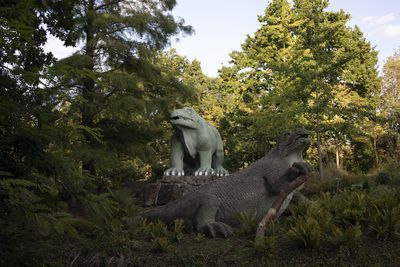
Mike Kemp/In PIctures via Getty Images
When I first saw the dinosaurs, some 15 or so years ago, I laughed. They were funny. They were wrong. They were funny because they were wrong. I was 20-odd years old and so I knew everything; certainly I knew what dinosaurs looked like. I’d seen Jurassic Park. As a child, I’d memorised every name from Aardonyx to Zupaysaurus and back again. And so, as a young and irritating adult, I knew just how silly and incorrect these weird lizards were.
They were built in the 1850s by Benjamin Waterhouse Hawkins, a sculptor and natural history artist, in collaboration with various experts in early paleontology including Richard Owen, the man who came up with the word “dinosaur.” They were based on reasoned extrapolations from the available fossils and they were, for their time, as good a job as anybody could likely have done. They became a minor sensation, and Queen Victoria and Prince Albert dropped by several times.
They even made it into literature — the titular hero of HG Wells’ Kipps takes his bride to be to walk among the “strange reminders of the possibilities of the Creator … huge effigies of iguanodons and deinotheria and mastodons and suchlike”:
Kipps meditated on the monstrous shapes in sight. “I wonder ‘ow all these old antediluvium animals for extinct,�� he asked. “No one could possibly ‘ave killed ‘em.”
”Why, I know that,” said Ann. “They was overtook by the Flood …”
Kipps meditated for a while. “But I thought they had to take two of everything there was —”
”Within reason they ‘ad,” said Ann …
The Kippses left it at that. The great green and gold Labyrinthodont took no notice of their conversation. It gazed with its wonderful eyes over their heads into the infinite — inflexibly calm.
But neither history nor paleontology have been kind. The park was ravaged by fire in the 1930s and afterwards the dinosaurs became run down. Even now, despite their addition to the UK’s list of protected constructions and ongoing restoration efforts, they still seem quaint. Polish them however you like, but Hylaeosaurus looks like a Harryhausen, the Teleosaurs raise their long snouts to the air like they’re tooting on trumpets, and the Labyrinthodonts, whatever Wells might have said, look like nothing so much as a pond of idling toads.

Moment Editorial/Getty Images
Of all London’s many parks, Crystal Palace is the most post-apocalyptic. As such the dinosaurs, long-fallen monarchs dragged forward through time by their planetary heirs, suit their space well. So does the coronavirus, as it goes: the quiet skies, the awkward distance, the sense of the world moving from a known past to an unknowable future.
It is named for a vast Victorian glass exhibition house that was built in Hyde Park, up in central London, to host the Great Exhibition of 1851. After the exhibition ended the whole edifice was taken down and moved eight miles south, to preside over a newly defined park in a leafy suburb. New lakes were dug, dinosaurs were built.
The Palace is no longer there. It burned down in 1936, and subsequent movements to rebuild the thing have founded on issues of cost, of time, and a general sense that there’s always something more important to be getting on with. But you can walk around the space where it was, which is still freighted with its absence. Stone mountings support a great emptiness. Grand steps carved into the landscape lead nowhere at all. Guardian sphinxes sit at rest, with nothing to watch over.
These sphinxes were recently restored and repainted a startling shade of red, somewhere between blood and rust. This, apparently, was their original colour, back when they guarded the steps of the Exhibition, but it has the odd effect of making them seem somehow less historical than they did. Old stone, historical stone, is crumbling and grey, stained with water and furred with moss. It wears its time like a lined face; the past can be read into it. Here the search for the authentic has produced something jarring, a double anachronism: they seem neither new nor old, but rather to have fallen out of time altogether.
Being older, wiser, and significantly more tired, and being reconciled to the fact I don’t know everything and often barely know anything, which I understand to be the condition of adulthood, I no longer find the wrongness of the dinosaurs funny. But I like them a lot more than I did. There is something encouraging and heartening about their wrongness. They stand now not as monuments to the power of Victorian science, an empire extending itself into the distant past, but bear witness to the fallibility of humanity.
Because, dear reader, it turns out that I was wrong as well. Jurassic Park was wrong.
I remember, as a kid, being impressed by the teeth and the horns and all the rest but most of all by the seriousness of dinosaurs: the grand longnecks, the terrible sharptooths. Even The Land Before Time is clear that its characters’ frivolity is a consequence of their childhood; the adult dinosaurs are just as serious as they should be. The dinosaurs I grew up with, once I’d left that early childhood stage where everything can be any colour and started reading books with pretensions to accuracy, were drab creatures. They ran from grey through brown and on to dark green, with just the occasional flash of colour to keep things interesting. Serious colours: all the flavours of military camouflage
We know better now. We know — we think we know; we are currently advancing as our best guess; the science has changed — that dinosaurs, or at least quite a few of them, were riotous explosions of feathers, profusions of colour. Hilarious, dramatic, and even a little bit camp. I wonder, sometimes, as I push the buggy past the Iguanodon’s portly shape, how the feathering of dinosaurs might have altered my childhood obsession. Perhaps it would have been less serious, less taxonomic — I know all the names! I am insufferable! — and more playfully strange. Or perhaps I would have just got into stamps instead.
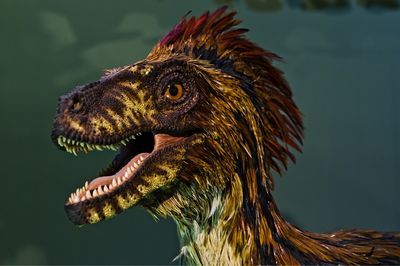
Imagno / Contributor / Getty Images
For Christmas, my partner and I bought our daughter an A to Z dinosaur poster, painted by the artist James Barker. The paintings are colourful, gleefully ridiculous, almost expressionist; a far cry from the greens and the greys of my youth. This is not an attempt to depict dinosaurs as they were, with as much accuracy as the moment allows. Rather, these are dinosaurs as they might have been. As it would have been fun for them to have been. Why shouldn’t Allosaurus be bright blue, with an orange head. Are you going to laugh at it?
The Crystal Palace monsters aimed for accuracy and so, as knowledge moved on, became ridiculous. Now they have been reclaimed, are celebrated in their wrongness. You can buy a T-shirt. Meanwhile the Crystal Palace sphinxes were restored with dutiful attention to authenticity, which has had the paradoxical effect of taking them out of all possible places. The dinosaurs on my daughter’s poster dance the line between these two: they are playfully, consciously incorrect. They peer out from behind their probable-feathers, a rainbow of possible-colours, and in their ambiguity they propose a relationship to the past that is imaginative and free. That takes what we know, acknowledges that we don’t know everything, and asks not what a thing should be, but what it could be.

Image courtesy James Barker
Fun fact: there was an Andrewsarchus. Not a dinosaur, not quite, but a prehistoric ungulate that slouched around what is now Inner Mongolia some 25 million years after the last Tyrannosaur lay down and died. As delightful as having my own almost-dinosaur was, however, it could not stop me cultivating an obscure jealousy of my brother, Peter, and his near-perfect overlap with the mighty Pteranodon.
0 notes
Photo

Zupaysaurus
Zupaysaurus (/ˌzuːpeɪˈsɔːrəs/; "ZOO-pay-SAWR-us") is a genus of early theropod dinosaur living during the Rhaetian stage of the Late Triassic to Hettangian stage of the Early Jurassic of what is now Argentina. Although a full skeleton has not yet been discovered, Zupaysaurus can be considered a bipedal predator, up to 4 meters (13 ft) long. It may have had two parallel crests running the length of its snout. More details Android, Windows
0 notes
Text
Neotheropoda

Source:��http://www.sciencemag.org/news/2014/10/new-meat-eating-dinosaur-lived-wake-mass-extinction
Group: Neotheropoda
Classification: Cellular Life, Archaea, Proteoarchaeota, Eukaryota, Unikota, Opisthokonta, Holozoa, Filozoa, Metazoa, Eumetazoa, Planulozoa, Bilatera, Nephrozoa, Deuterostomia, Chordata, Craniata, Vertebrata, Gnathostomata, Eugnathostomata, Teleostomi, Euteleostomi, Sarcopterygii, Rhipidistia, Tetrapodomorpha, Eotetrapodiforms, Elpistostegalia, Stegocephalia, Tetrapoda, Reptiliomorpha, Anthracosauria, Batrachosauria, Cotylosauria, Amniota, Sauropsida, Eureptilia, Romeriida, Diapsida, Neodiapsida, Sauria, Archosauromorpha, Archelosauria, Archosauriformes, Crurotarsi, Archosauria, Avemetatarsalia, Ornithodira, Dinosauromorpha, Dinosauriformes, Dinosauria, Saurischia, Eusaurischia, Theropoda
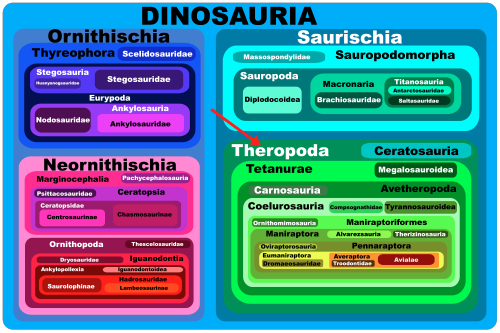
Definition: The group including the most recent common ancestor of Ceolophysis and modern birds, and all of that animal’s descendants

Organisms Within: Zupaysaurus, Tachiraptor, Dilophosauridae (not examined here), Coelophysoidea (not examined here), Averostra (not examined here), & two miscellaneous genera without further placement.
Time Range: Shown below, numbers on the left in millions of years. Though the only basal Neotheropods known are from the Triassic-Jurassic boundary, members of other groups are present much earlier than that, about 220 million years ago, implying that they must have evolved at around that time or older.
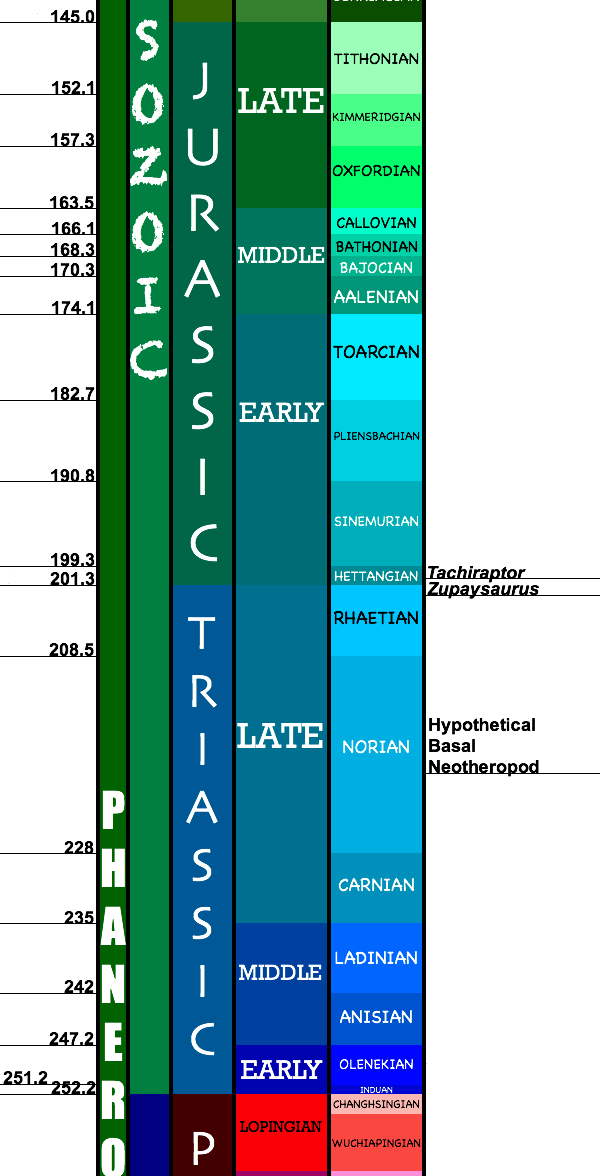
Characteristics:
Neotheropods differ from basal theropods mainly on a few skeletal points. The ilium bone in the pelvis, expanded towards the top of the animal (dorsally). The snout is more narrow than in basal theropods, there are more vertebrae fused to the hips, there is a complete loss of the fifth digit of the foot (as shown below), and a general stiffening of the legs overall.
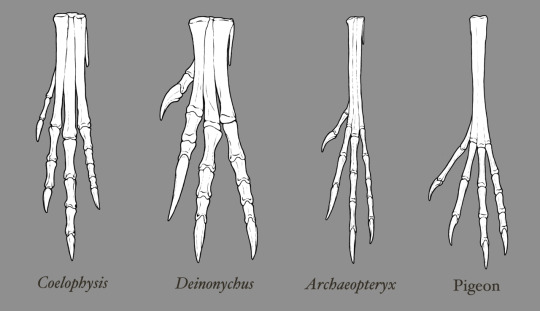
By @ewilloughby
Like all early dinosaurs, Neotheropods were probably covered in a layer of primitive feathers - though some theropods groups would later lose feathers, the general line leading up to birds must have kept them, given that birds have feathers. They were bipedal, fast predators, and basal members of Neotheropoda were probably outcompeted by later animals, and even during their existence Coelophysoids were far more common.

Source: @alphynix
Fossil Locations: It is fairly likely that Neotheropods also originated in Argentina, during that very rapid early diversification of dinosaurs in the region. This assessment is based mainly on the presence of basal theropods mainly in the region, though its possible that it also occurred in North America, where many Coelophysoids lived. Coelophysoids have also been found in Europe and Asia, and so given this widespread range of this group and its early evolution, as well as the locations of basal theropods, its reasonable to suppose that Argentina is where they started, unless evidence to the contrary comes to light.
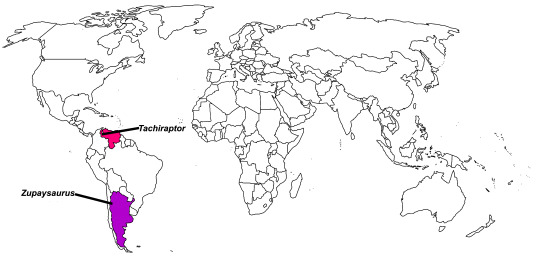
Biogeography: Neotheropods spread throughout the globe, as described above; this was relatively easy due to Panagaea, however, most Coelophysoids congregated around North America and Europe. The two basal members of the group stayed in South America. Maps from Dr. Christopher Scotese.
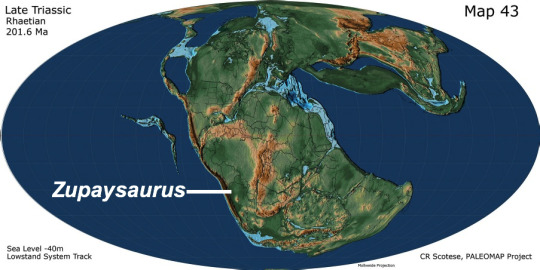
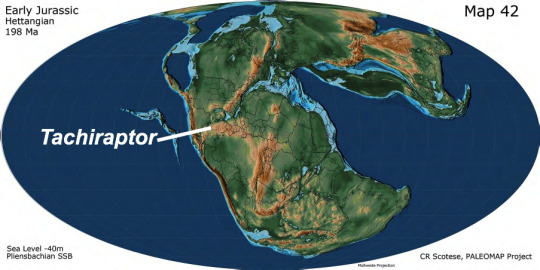
Read more about Zupaysaurus here!
Read more about Tachiraptor here!
Read more about Coelophysoidea here!
Posts on Dilophosauridae and Averostra to come soon!
Sources:
https://en.wikipedia.org/wiki/Neotheropoda
http://palaeos.com/vertebrates/theropoda/neotheropoda.html
https://en.wikipedia.org/wiki/Zupaysaurus
https://en.wikipedia.org/wiki/Tachiraptor
Shout out goes to @chequitablr!
Miscellaneous Neotheropods not examined here that do not have further placement (links added as I do posts on them):
Altispinax
Szechuanosaurus
#neotheropoda#dinosaurs#zupaysaurus#tachiraptor#biogeography#geologic time scale#paleontology#geology#biology#prehistory#prehistoric life#group in depth#nature#gid#science#dinosaur group#chequitablr#dinosaure#恐龙#ডাইনোসর#دایناسور#dinosaurio#динозавр#ไดโนเสาร์#डायनासोर#ديناصور#恐龍#risaeðla#dinozor#ڈایناسور
153 notes
·
View notes
Photo

The Devil lizard, Zupaysaurus (2003)
Phylum : Chordata Class : Reptilia Order : Saurischia Suborder : Theropoda Genus : Zupaysaurus Species : Z. rougieri
Late Triassic/early Jurassic (200 - 197 Ma)
4 m long and 240 kg (size)
Los Colorados formation, Argentina (map)
Judging by its single, incomplete specimen, Zupaysaurus appears to have been one of the earliest theropods, the two-legged, carnivorous dinosaurs of the late Triassic and early Jurassic periods that eventually evolved into giant beasts like Tyrannosaurus a hundred million years later.
At 13 feet long and 500 pounds, Zupaysaurus was fairly large for its time and place (most other theropods of the Triassic period were about the size of chickens), and based on which reconstruction you believe, it may or may not have had a pair of Dilophosaurus-like crests running down the top of its snout. These crests are thought to have been formed by the nasal bones solely, unlike those of many other theropods which also incorporated the lacrimal bones. Crests on the skull were pervasive among theropods and may have been used for communicative purposes such as species or gender recognition. However, more recent analysis of the skull has cast doubt on the presence of these crests in Zupaysaurus. An unpublished abstract presented at a recent conference indicated the structures initially identified as crests were in fact the lacrimal bones displaced upwards during the process of fossilization. Other cranial ornamentation included a rugose laterally-projecting lacrimal ridge on the top of the skull
95 notes
·
View notes